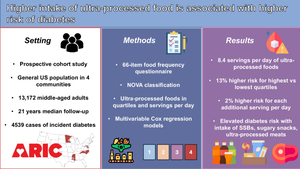Diabetologia ( IF 8.4 ) Pub Date : 2024-07-13 , DOI: 10.1007/s00125-024-06221-5 Shutong Du 1, 2 , Valerie K Sullivan 1, 2 , Michael Fang 1, 2 , Lawrence J Appel 1, 2, 3 , Elizabeth Selvin 1, 2, 3 , Casey M Rebholz 1, 2, 3

|
Aims/hypothesis
Understanding the impact of the overall construct of ultra-processed foods on diabetes risk can inform dietary approaches to diabetes prevention. In this study, we aimed to evaluate the association between ultra-processed food consumption and risk of diabetes in a community-based cohort of middle-aged adults in the USA. We hypothesised that a higher intake of ultra-processed foods is associated with a higher risk of incident diabetes.
Methods
The study included 13,172 participants without diabetes at baseline (1987–1989) in the Atherosclerosis Risk in Communities (ARIC) study. Dietary intake was assessed with a 66-item semiquantitative food frequency questionnaire, and foods were categorised by processing level using the Nova classification system. Ultra-processed food was analysed categorically (quartiles of energy-adjusted intake) and continuously (per one additional serving/day). We used Cox regression to evaluate the association of ultra-processed food intake with risk of diabetes with adjustment for sociodemographic characteristics, total energy intake, health behaviours and clinical factors.
Results
Over a median follow-up of 21 years, there were 4539 cases of incident diabetes. Participants in the highest quartile of ultra-processed food intake (8.4 servings/day on average) had a significantly higher risk of diabetes (HR 1.13; 95% CI 1.03, 1.23) compared with participants in the lowest quartile of intake after adjustment for sociodemographic, lifestyle and clinical factors. Each additional serving of ultra-processed food consumed daily was associated with a 2% higher risk of diabetes (HR 1.02; 95% CI 1.00, 1.04). Highest quartile consumption of certain ultra-processed food groups, including sugar- and artificially sweetened beverages, ultra-processed meats and sugary snacks, was associated with a 29%, 21% and 16% higher risk of diabetes, respectively, compared with the lowest quartile.
Conclusions/interpretation
We found that a higher intake of ultra-processed food was associated with higher risk of incident diabetes, particularly sugar- and artificially sweetened beverages, ultra-processed meats and sugary snacks. Our findings suggest interventions reducing ultra-processed food consumption and specific food groups may be an effective strategy for diabetes prevention.
Graphical Abstract
中文翻译:

超加工食品消费与糖尿病风险:基于人群的前瞻性队列研究结果
目标/假设
了解超加工食品的整体结构对糖尿病风险的影响可以为预防糖尿病的饮食方法提供信息。在这项研究中,我们旨在评估美国中年社区人群中超加工食品消费与糖尿病风险之间的关联。我们假设超加工食品的摄入量越高,患糖尿病的风险越高。
方法
该研究纳入了社区动脉粥样硬化风险 (ARIC) 研究中的 13,172 名基线(1987-1989 年)没有糖尿病的参与者。通过 66 项半定量食物频率调查问卷评估膳食摄入量,并使用 Nova 分类系统按加工水平对食物进行分类。对超加工食品进行分类(能量调整摄入量的四分位数)和连续分析(每额外一份/天)。我们使用 Cox 回归来评估超加工食品摄入量与糖尿病风险的关联,并调整社会人口特征、总能量摄入量、健康行为和临床因素。
结果
在中位随访 21 年中,共有 4539 例糖尿病病例。经过社会人口统计学调整后,与摄入量最低四分位数的参与者相比,超加工食品摄入量最高四分位数(平均每天 8.4 份)的参与者患糖尿病的风险显着更高(HR 1.13;95% CI 1.03,1.23) 、生活方式和临床因素。每天每多吃一份超加工食品,患糖尿病的风险就会增加 2%(HR 1.02;95% CI 1.00,1.04)。某些超加工食品组(包括含糖和人工甜味剂饮料、超加工肉类和含糖零食)摄入量最高的四分位数与最低摄入量相比,患糖尿病的风险分别高出 29%、21% 和 16%四分位数。
结论/解释
我们发现,超加工食品的摄入量越高,患糖尿病的风险越高,特别是含糖饮料和人工甜味剂饮料、超加工肉类和含糖零食。我们的研究结果表明,减少超加工食品消费和特定食物类别的干预措施可能是预防糖尿病的有效策略。











































 京公网安备 11010802027423号
京公网安备 11010802027423号